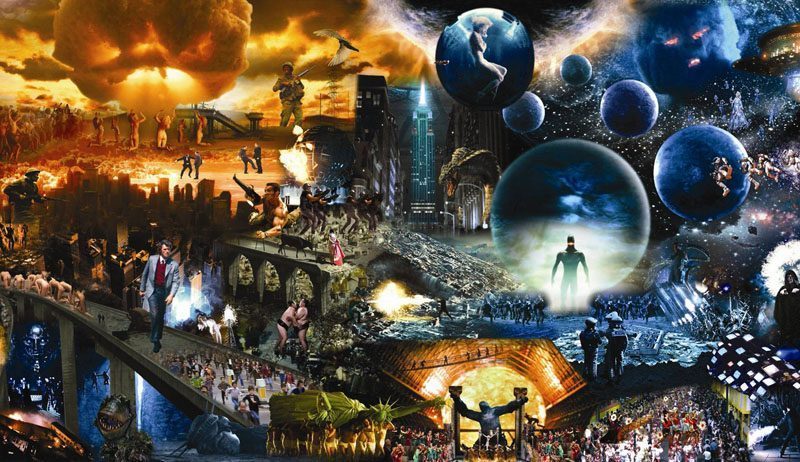A century after the first film experiments, moving image is an inevitable part of our visual culture. We interact constantly with moving images on different screens: computers, mobile phones and game consoles. With the development of portable equipment and social networks on the Internet, the making, screening and distribution of film have become available to everyone. One could say that we have now reached the stage after film, a shift in technologies, maybe as decisive as the invention of film itself. A sad consequence of the invention of new technologies is that other techniques have to move to the graveyard of the outmoded and the obsolete. Those funerals also mean the burial of a certain vision.
How those shifts, those births and deaths in the history of the moving image, influence and change art is the core in this spring’s major exhibition project A Trip to the Moon.
But Persona is also very much a film about cinema, about the materiality of film. That theme links to the main concept in my performance, where each of the 24 performers represents one frame of a moving image strip.
Ming Wong
In the exhibition viewers are presented with contemporary artists who employ moving imagery as their tool to express the theme of the history and future of filmmaking. The fascination of the field of visual arts with film extends right back to the moment the film camera was invented. In order to delve into the debate that has always existed between these two art forms, we will be screening a selection of historical feature films and shorter video installations as footnotes in the exhibition. Video art often serves as a commentary on the role of film in society as a whole, as well as exploring the vast possibilities offered by the medium of film.

A Trip to the Moon according to Roy Andersson, 21 March
Roy Andersson is a truly prominent figure in the Swedish film world. On 21 March, he screens A Trip to the Moon, showing it from his own personal perspective.
Roy Andersson has become infamous for his distinctive, unique language of storytelling. He fills a number of roles, including that of film director, scriptwriter, filmmaker and commercial director. He has been working in the film industry since the late 1960s and runs independent production company Studio 24, producing everything from feature films to art exhibitions and books. Roy Andersson is also an Honorary Doctor at the University of Gothenburg and has served as an Honorary Chairman of the Gothenburg International Film Festival since 2009. Roy Andersson was educated at the Swedish Film Institute’s Film School in Stockholm.
Before and After Cinema, Programme at Sture Cinema
Before and After Cinema is a collaboration between Bonniers Konsthall and Moderna Museet, delving into the role of moving imagery in the art world, from the early 1900s to today and well into the future. Follow our collective programme of events taking place throughout the spring!
Three evenings at Sture Cinema
In collaboration with SFI (Swedish Film Institute).
Artists in the cinema space, 15 February 6:30pm
More and more artists are producing films for the big screen. Film screening and discussion. Axel Petersén, Tova Mozard, Stefan Constantinescu, Andra Lasmanis, Fia-Stina Sandlund. Moderator: Caroline Elgh.
Bergman in art, 29 February 6:30pm, Small auditorium.
Contemporary artists and Ingmar Bergman. Film screening and discussion. Hynek Pallas, Sara Jordenö, Thomas Broomé, Markus Öhrn, Marcus Lindeen. Moderator: Catrin Lundqvist.
Silent films, 28 March 6:30pm, Large auditorium.
Georgina Starr: Theda, silent film from 2007, 40 min, based on silent film star Theda Bara (1885–1955). Cellist Peter Schuback performs music he composed for the film. Bo Florin introduces the evening.
The fact that only 20 per cent of all silent films have been saved interested artist Georgina Starr when she began her work on the piece Theda. Silent film star Theda Bara (1885–1955) acted in over 20 films, only two of which remain to this day. Georgina Starr began a process in her studio where she performed the lost films. Building sets and creating props and costumes, she filmed herself acting out the roles. The resulting 37-minute silent film is accompanied by newly composed music at each and every screening. For the screening at Sture Cinema, Starr has invited cellist Peter Schuback to perform live music along to the film, in true silent film fashion. Bo Florin, professor and silent cinema expert from Stockholm University, will introduce the screening. The participants will answer audience questions after the screening.
Before and After Cinema: International symposium 9–10 March.
Arranged with Stockholm Academy of Dramatic Arts.
Seminar on the moving image in art. Eilja-Liisa Ahtila, Sara Arrhenius, Daniel Birnbaum, Jan Holmberg, Christiane Paul, Ming Wong. Moderator: Magdalena Malm. Discussions and film screenings. Read more in the programme.
Top image: Ming Wong, Persona Performa, 2011. Foto: Olle Kirchmeier